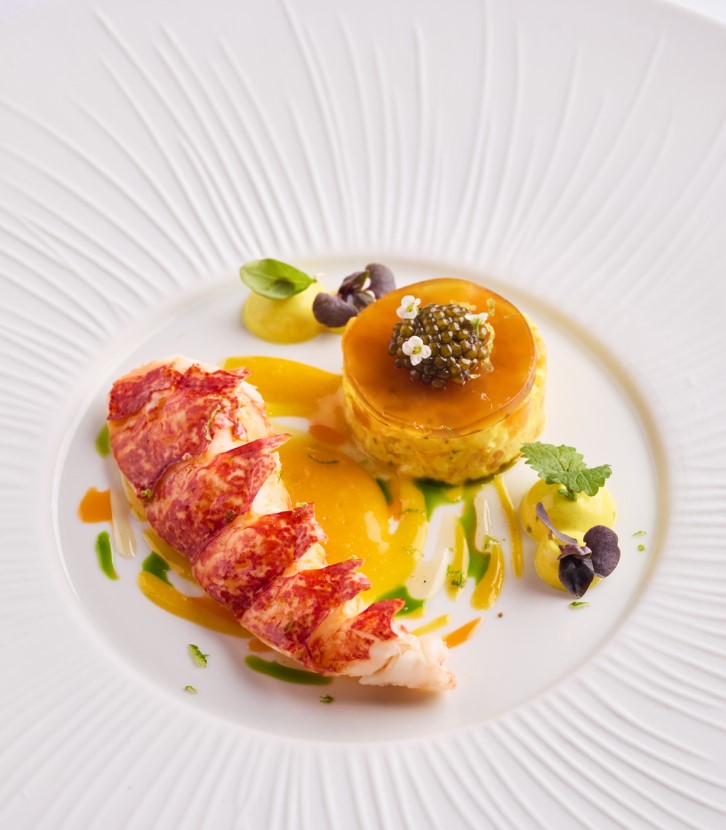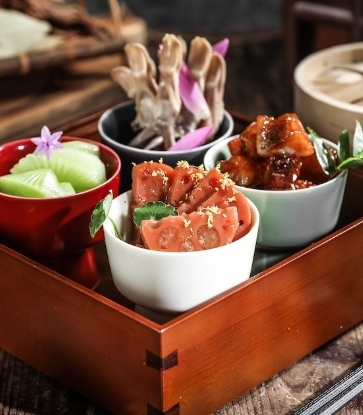The cold wave makes us reminisce about the past. But where can we find food with nostalgic flavours that is part of this city?
Qiao Ai Lai Lai Xiao Long (Huangpu)
Bib Gourmand, MICHELIN Guide Shanghai
Tucked away at the back of Nanjing Road Pedestrian Street, nearly three decades have flown by since Qiao Ai Lai Lai Xiao Long (Huangpu) was founded in 1994 and transformed from a wonton and noodle eatery into a place known for its crabmeat Xiao Long Bao.
RELATED: 148 Restaurants Shine in the MICHELIN Guide Shanghai 2024, Including 5 New One-Starred Restaurants

The shop has a small facade and is always packed when it comes to mealtimes. Mr. Cheng, the founder of Lai Lai, was inspired by a crabmeat family dinner with his friends and found a way to improve his eatery with crabmeat Xiao Long Bao. And the constant shutdowns in the past three years didn't dampen his passion. The recent visit paid by Roger Federer and many Japanese tourists again made Lai Lai a trending topic.

The little shop offers Xiao Long Bao in flavors such as crabmeat, shrimp with crabmeat, and crabmeat and pork with matsutake mushroom. Despite the higher cost, Mr. Cheng insists on using live crabs and hand-picked crabmeat, and there are not many restaurant owners who is willing to go to the crabmeat factory in Suzhou to pick crabmeat in person.
With a rich crab flavor but no fishy taste, the Xiao Long Bao is not overly delicate, but the skin is thin enough that when lightly lifted and shaken it feels like the crab oil and broth is going to break through the outer skin. When you gently bite into the top of the skin, the special ginger vinegar blends in with the meat.

This season is indeed the best time to enjoy Lai Lai Xiaolong.
For those of you who haven't yet visited, make sure you drop in Lai Lai and rediscover childhood offered by this upgraded version of Xiao Long Bao stuffed with crabmeat and crab paste on a road which may not look much like old Shanghai anymore.The Xiao Long Bao here is all about the inner universe of Mr. Cheng.
If you want a more artistic setting to have a steamer of Xiao Long Bao at the end of the crab season, take an 800-metre walk from Lai Lai to Cheng Long Hang (Huangpu).
Cheng Long Hang (Huangpu)
One MICHELIN Star, MICHELIN Guide Shanghai
In Chapter 38 of the Dream of the Red Chamber, the Jia Family set up a banquet in the water pavilion during October and November, and the crabs shipped from Jiangnan, a geographic area in China referring to lands immediately to the south of the lower reaches of the Yangtze River, shaped a classic image of the rich and noble in the Grand View Garden. Today, One-MICHELIN-Starred restaurant Cheng Long Hang (Huangpu) brings the crab feast from the book to the reality, showing the story and elegance of flavors with crabmeat and crab paste presented in different ways.

People in Hong Kong and Japan are all crab lovers. The owner of Cheng Long Hang, Ke Wei, was engaged in the hairy crab trade in his early years, and after earning his first bucket of gold with the business of delivering hairy crabs to Hong Kong, he built his own crab breeding base on Yangcheng Lake. They even opened a branch in Tokyo four years ago.
Today, let’s only look at crab roe Xiao Long Bao, for which you will only be offered one piece in any of Cheng Long Hang's set menus, but is so unforgettable that you'll want to order a second one immediately.

It would not be an exaggeration to call it an exquisite dim sum of the Grand View Garden, with its delicate size, garnished with crab roe at the top, and the first sip of the soup will make you appreciate the difference. Served with lemon juice, this steamer of Xiao Long Bao that lasts for all four seasons is enough to justify you as a regular visitor to the Crab Palace.

Nanxiang Steamed Bun (City God Temple)
Bib Gourmand, MICHELIN Guide Shanghai
The City God Temple is another chapter of the vibrant and bustling city of Shanghai.
A small part of the old City God Temple Lane is retained along the Fangbang Middle Road, which is dilapidated but more of the original beauty. The Yuyuan Garden has been completely refurbished, and even the Nanxiang Steamed Bun (City God Temple) beside the Jiuqu Bridge has been renovated as well.
Nanxiang is one of the four famous historical towns of Shanghai and is named after the temple in the town. Nanxiang people love to go to the teahouses, and tea must be accompanied by snacks.

In 1871, during the Tongzhi period of the Qing Dynasty, Huang Mingxian, the owner of Ri Hua Xuan teahouse in Nanxiang, invented `Xiao Long Steamed Buns, which can be eaten in one bite. The heirs of Nanxiang Xiao Long Bao have chosen to stick to the tradition in turbulent times. From Nanxiang teahouse to the City God Temple, Nanxiang Steamed Bun is now made by the sixth-generation inheritor, chef You Yumin.
Sticking to traditions doesn't mean refusing to change. In the City God Temple store, you can find a full-page menu of different flavors, including the traditional pork stuffing, vegetables and fresh mushrooms, truffle and velvet mushroom, clams, and pork, as well as the famous crab roe soup buns. Together with the tea set menu launched by the century-aged teahouse, you can experience the classic Shanghai-style life of "having a steamer of soup buns with a pot of tea" to your heart's content.

In recent years, brand rejuvenation has been the focus for many long-established restaurants. While catering to the preferences of the young generation, various trendy flavors also help to carry forward traditional dishes. The Nanxiang Steamed Bun (City God Temple) has recently launched a new flavor of coriander and salted egg yolk. With a hundred years of know-how in hand, on the way to developing new flavors, it only needs authentic ingredients, good taste and appropriate fusion to be considered a big success.

Jing Mei Wu Xi Si Fang Mian Guan
Bib Gourmand, MICHELIN Guide Shanghai
Elegant old Shanghai houses are many travellers’ first impression of Shanghai style. Jing Mei Wu Xi Si Fang Mian Guan on Yanping Road is a private noodle shop from Wuxi and is famous for making pork rib noodles. The young owner-couple brought this bowl of Taiwanese crispy short rib noodles back to their hometown on their way to explore food from all over the world.
Landscapes and fields can be seen everywhere in Jiangnan, abounding in rice, fish and shrimp, and a variety of aquatic plants. Everything is bright and beautiful. The shared respect and deep cultivation of regional cultures is what makes people in Jiangnan live peacefully together.

Wuxi's reputation for sweetness was documented in the Yuan Dynasty. In the ancient recipes, Wuxi people would use honey, sugar, sweet wine, and other flavourings when cooking braised meat and making snacks. Wuxi's sweetness is unmatched by any other city in China.
No matter in which city, Xiao Long Bao must be steamed immediately after ordering and eaten while hot before the broth gets cold. Wuxi Xiao Long Bao is a bit thicker than Shanghai Xiao Long Bao, filled with Wuxi's signature sweet and salty meat stuffing, and with lots of soup. The flavour of Jing Mei is nostalgic and romantic, reminding you of the sunshine in the living room of a winter home.
Xiao Long Bao masters are found all over Jiangnan. The aroma of dim sum wafting out of a bamboo steamer in winter gives a simple but powerful encouragement in the monotonous life.
The article is written Joyii, translated by Mengjie Zhang.
Hero image: Cheng Long Hang (Huangpu). All photos by Joyii.





















